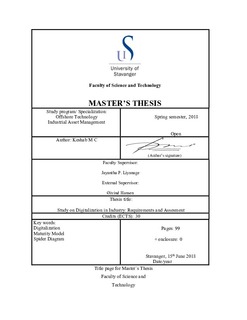| dc.contributor.advisor | Liyanage, Jayantha P. | |
| dc.contributor.author | MC, Keshab | |
| dc.date.accessioned | 2018-09-13T07:54:30Z | |
| dc.date.available | 2018-09-13T07:54:30Z | |
| dc.date.issued | 2018-06 | |
| dc.identifier.uri | http://hdl.handle.net/11250/2562351 | |
| dc.description | Master's thesis in Offshore Technology: Industrial Asset Management | nb_NO |
| dc.description.abstract | Digitalization is a way of companies preparing for the future. Most large established enterprises embark on the digitalization process without a sense of direction. This research will provide a way forward for the digitalization of a company. The research will evaluate the various requirements for digitalization of a business. The process uses the digital capabilities to demonstrate how a traditional enterprise can be transformed into a top performer in its industry as well as the digital economy. The research will examine the organizational requirements for a company to achieve digitalization. The barrier and facilitators in each of the requirements will be evaluated. The research was divided into two parts; the first part included the evaluations of the organizational requirements for digitalization. This part provided the literary background of the requirements highlighting the barriers and facilitator in each case. The background study also evaluated how these requirements affect the digitalization process. The second part: entail the creation of maturity model and spider diagrams for the requirements discussed in part one. This empirical analysis provided and qualitative analysis of the requirements. In the qualitative analysis, a variety of categories were selected to segregate the requirements. The digitalization of an organization was evaluated on the basis of various significant factors. The factors would be essential in affecting the digitalization efforts of an organization by either promoting digitalization or decreasing the success levels of the digitalization efforts. Some of the factors affected the human interaction with the new technology or the work process. The factors were evaluated in the maturity model to show the level of maturity of the organization with regards to digitalization. The factors were also evaluated using the spider diagram based on the significance and the cost incurred in implementation. Leadership was the most vital component while strategy was the most expensive element. | nb_NO |
| dc.language.iso | eng | nb_NO |
| dc.publisher | University of Stavanger, Norway | nb_NO |
| dc.relation.ispartofseries | Masteroppgave/UIS-TN-IMBM/2018; | |
| dc.rights | Navngivelse-DelPåSammeVilkår 4.0 Internasjonal | * |
| dc.rights.uri | http://creativecommons.org/licenses/by-sa/4.0/deed.no | * |
| dc.subject | industriell driftsledelse | nb_NO |
| dc.subject | industrial asset management | nb_NO |
| dc.subject | digitalization | nb_NO |
| dc.subject | maturity model | nb_NO |
| dc.subject | spider diagram | nb_NO |
| dc.title | Study on Digitalization in Industry: Requirements and Assessment | nb_NO |
| dc.type | Master thesis | nb_NO |
| dc.description.version | submittedVersion | nb_NO |
| dc.subject.nsi | VDP::Teknologi: 500::Marin teknologi: 580::Offshoreteknologi: 581 | nb_NO |

